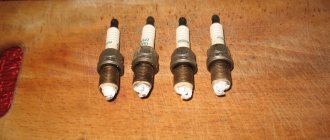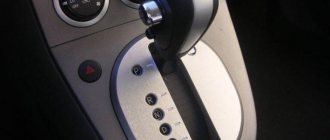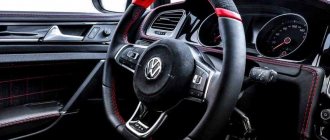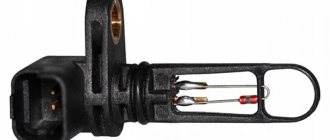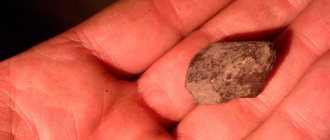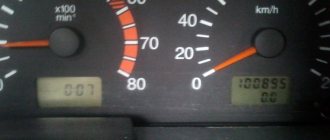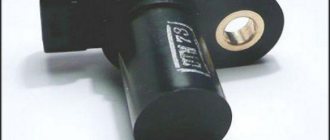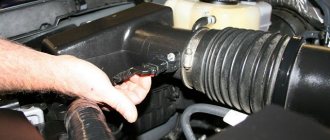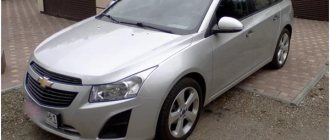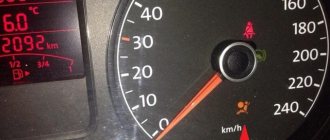Many drivers consider a slight discrepancy in the proportions of the air-fuel mixture to be normal. From the point of view of the current level of technical means used in injection systems, the tolerances are minimal, therefore deviations manifested by changes in engine operation cannot be called standard.
In other words, if the air-fuel mixture becomes rich or lean, this is a clear indication that there are problems in the preparation of the fuel assembly. As a rule, serious violations of the mixture formation process are accompanied by the appearance of corresponding errors issued by the on-board computer. And these problems are typical for engines of all types - gasoline and diesel, injection and carburetor, and even those running on liquefied gas.
Error p0171 is one of them, and today we will tell you what it means, what consequences it can lead to, how it is diagnosed and corrected.
What does code p0171 mean?
Over more than a century of history of the existence of internal combustion engines, it has been established that the ideal proportion of fuel assemblies, facilitating the most complete combustion of the mixture under pressure in the cylinders, is 1:14.7. That is, for 1 liter of gasoline supplied to the injection system, it is necessary to supply 14.7 liters of air.
The injection system (injection or carburetor) is precisely responsible for preparing the fuel assembly in exactly this proportion. Of course, in certain situations it can be changed (for example, if you need to quickly increase the thrust of the power unit or, conversely, switch to a more economical operating mode). The decision on this is made by the ECU, but in any case it can determine how accurately the actuators carry out its instructions. And if, for example, more fuel enters the combustion chamber than necessary, such a mixture is called enriched; if less, it is called lean. In both cases, the normal operation of the motor is disrupted, and if no measures are taken to correct the situation, the matter may result in engine failure.
In principle, experienced drivers are familiar with the symptoms indicating problems with the air-fuel mixture. But the problem is that most of these signs are ambiguous, manifesting themselves in other malfunctions. Therefore, to make it easier to diagnose the problem, the on-board computer informs the driver about the malfunction by displaying an error.
Error code P0171 just means that the mixture is lean, that is, the engine does not receive enough gasoline compared to air.
How to fix error P0171
To eliminate error P0171, it is necessary to determine the exact cause of the formation of a too lean air-fuel mixture. You need to start with a detailed diagnosis of engine systems. It is necessary to check the correct operation of the sensors that are involved in the formation of mixture quality:
- oxygen;
- fuel and air pressure;
- temperature;
- mass air flow;
- crankshaft and camshaft.
Next, check for air leaks. For this purpose, service stations often use smoke machines. Smoke is pumped under pressure into the intake manifold, and the fact of unauthorized leakage through gaskets or other damage is checked.
Then the injection quality is monitored, first using diagnostic equipment, then by placing the dismantled injectors on a special stand. Incorrectly functioning injectors are restored or replaced.
Video - error P0171 lean mixture (injector):
The pressure in the ramp is checked, preferably not using diagnostics, but using a verified pressure gauge. If the pressure does not meet the required level, you should check the fuel pump, pressure regulator, condition of the fuel pipes and filters.
In case of temporary occurrence of error P0171, it is better to act in the following sequence:
- replace fuel in the system;
- change fine and coarse fuel filters;
- check for possible suction in the intake manifold, tighten the manifold mounting bolts;
- check the fastening of connectors on sensors and regulators.
If these measures do not help, proceed with a full diagnosis of the engine and fuel system.
Reasons for code p0171
From the point of view of a car service specialist, these are fairly standard reasons. Often you can quickly and easily fix them yourself, but in some cases you may need the help of specialists.
Unfortunately, quite often the drivers themselves are responsible for the occurrence of this error. They deliberately change the composition of the fuel assembly, making appropriate adjustments - this possibility is present in both carburetor power units and their injection analogues. In particular, changing the position of the locking ring by moving it into adjacent grooves of the throttle needle, changing its angle. Of course, the intentions in this case are the best - to reduce fuel consumption, but the consequences, to put it mildly, are not so good.
The same result can be achieved by changing the ECU program code, which is done using a special device (programmer).
But if in the first case it is quite easy to correct the situation by performing the opposite action to the original one, then reprogramming the on-board computer is always associated with increased risks of getting, instead of one problem, many others with uncertain prospects for identifying them.
Still, this reason can be called atypical, but clogging of the fuel filter and injectors is an inevitability against which there are no effective ways to combat it, other than regularly replacing the filter elements and cleaning the injectors.
We can say that this is the most common reason for the on-board computer to generate error 0171 (lean mixture). The needle of modern injectors has a very small diameter, and due to the presence of suspensions in low-quality fuel, they can be deposited on the walls of the needle and nozzle of the injector, reducing their throughput. As a result, less fuel enters the combustion chamber, and over time this process only progresses.
Car owners who refuel exclusively at network branded gas stations are exposed to this risk to a much lesser extent than those who have the habit of refueling where the cost of fuel is lower.
But if the inevitable has already happened, you should replace the fine/coarse filter (this operation can be done independently), and also wash the nozzles, for which specialized bench equipment is used. You can wash the injectors yourself, but the quality of such work usually leaves much to be desired.
Clogging of the injectors can also be caused by a dirty fuel tank, at the bottom of which dust, sand and other contaminants usually accumulate, which are subsequently sucked into the system by the fuel pump.
An ECU error interpreted as a “lean mixture” may also appear due to a leak in the fuel assembly preparation system. Air leaks can occur in different places - for example, as a result of damage to the pipes leading from the air filter to the intake manifold due to damage to the manifold itself, at the place where the DX is installed.
If the hose and the collector body are damaged, they need to be replaced, and if cracks appear on the collector, such repairs will cost you a pretty penny. If it turns out that air is leaking through the idle speed sensor, the rubber sealing ring should be replaced - most likely, it is responsible for the depressurization.
Of course, malfunctions of the fuel pump also lead to an insufficient amount of fuel entering the combustion chamber, but there are other reasons that result in a lean fuel assembly.
So, if an error code p0171 appears, it is better not to troubleshoot the problem yourself, but to immediately contact a car service center, whose specialists can quickly localize the cause of the problem.
Diagnosis and problem solving
A dirty MAF sensor can skew air intake measurements and therefore skew fuel injection calculations. Next, check the fuel pressure to make sure it is in the correct range. Excessive pressure, due to a faulty pressure regulator or a compressed line tube, will cause more fuel to be injected than the ECU expected.
Check that the ECT and IAT (inlet air temperature) readings are correct. The ECU can pick up blocked sensors, so it's good to check that the ECT and IAT readings are within the normal range.
For example, if the engine is running for half an hour on a hot day, the ECT should show a temperature of about 80°C. If it still reads 0°C, the ECU will richen the air/fuel mixture to compensate, resulting in a rich condition.
Reduced fuel pressure
With the engine running, record the fuel pressure, and then stop the engine. Fuel pressure may drop slightly but should remain stable for at least 10 or 15 minutes.
If fuel pressure continues to drop, you may have a leaking fuel injector, which will result in a rich and possibly non-ignitable condition.
Valve blocking
A faulty valve in the cylinder head dumps unburned fuel into the exhaust gas stream. Check and correct this problem before attempting to correct a rich air/fuel mixture error.
Pay attention to other trouble codes that may be present at the same time as P0171. For example, for VVT (variable valve timing) or ignition system.
Traffic fumes
Check the exhaust system for leaks, especially in front of the first O₂ sensor. Damage can be mechanical, in the form of cracks, or caused by corrosion.
The entry of atmospheric air before this sensor can distort the oxygen content measurements. At the same time, the ECU will try to compensate the mixture and add fuel.
Operation of the power unit on a lean mixture
First, you need to understand the very concept of “lean mixture”. The combustion chamber is a sealed container, the volume of which is dynamic, that is, it changes depending on the phase of movement of the piston. Injecting only fuel into the cavity will do nothing - without oxygen, it simply cannot burn, that is, oxidize.
Moreover, a certain amount of oxygen is required to maintain the combustion process. Since the air-fuel mixture is under pressure at the moment the spark is given, its ignition is fleeting and explosive in nature. But for this it is necessary that for each volumetric part of gasoline there are about 15 parts of air. It is in this situation that the highest power is achieved with minimal consumption.
Reducing the proportion of air to a proportion of 1:12-1:13 will lead to the mixture burning more actively, producing more power, but the consumption will, for obvious reasons, increase. But such a dynamic is not linear: a further decrease in the amount of air will lead to the fact that such an enriched fuel assembly, upon reaching a certain concentration (1:5-1:8), generally loses the ability to ignite. The cylinder stops working, and in intermediate phases it will malfunction.
The consequences will be equally negative in the reverse process, when less fuel enters the cylinders than usual. In the early stages, this leads to a decrease in fuel consumption while simultaneously reducing the power of the power unit, but at a ratio of 1:21-1:22 the mixture also stops igniting. So, as we see, a depleted fuel assembly is just as dangerous as an enriched one.
As we already know, the on-board computer is capable of influencing the composition of the mixture, but it does this within completely safe ranges, depending on the operating mode of the engine. Thus, when driving in direct transmission at cruising speed, it makes no sense to supply a stoichiometric (rich) fuel assembly to the combustion chamber. As the load increases (a typical example is going uphill when driving at high speeds in a lower gear is required), the engine is required to work at the limit that only a rich mixture can provide.
If the ECU gives an error “mixture too lean”, we can talk about two global reasons: insufficient fuel is supplied to the cylinders, or too much air is supplied. Regardless of the reason, in such cases the engine will be difficult to start, in idling mode its operation will be unstable, and an attempt to move off often ends with the engine stalling. During the active phase, sharp pressure on the accelerator pedal goes unnoticed: acceleration does not occur, and the power unit begins to “choke.” At the same time, the car twitches and behaves unpredictably.
To be fair, we note that the same symptoms can be observed with other problems, in particular, with a broken ignition timing. “Sneezing” of the engine when the mixture is lean is typical for carburetor engines; this can be evidenced by loud pops coming from the intake manifold on the injector. If, as a result of checking the condition of the car’s ignition system, no problems are identified, it can be assumed that this behavior of the engine is caused by problems in the power supply/injection system.
In principle, deviations from the norm can be determined by assessing the color of soot on the candles. If it is light brown, there is no need to worry about mixture formation, since such a shade indicates normal combustion of the fuel assembly.
If the candles are black, the mixture is over-enriched and does not burn completely. A whitish or grayish coating indicates that the power unit has to operate on a lean mixture, which leads to its overheating and faster wear of all units and components.
But let us remind you once again that diagnosing the mixture using spark plugs cannot be called an accurate diagnostic method, because the same symptoms are characteristic of a number of problems in the ignition system.
Error P0171 - Air-fuel mixture too lean
Error P0171 is one of the most common. It is detected when the car is scanned by a computer. Fortunately, there is nothing terrible about it and it is relatively simple and cheap to fix. Error code P0171 means the mixture is too lean on cars with fuel injection, which is the majority. Below we will look in more detail at the reasons for its occurrence and how to eliminate it yourself. Well, if you are not going to fix it yourself, in any case, they won’t charge you extra money at the service station.
So, to understand what this error means, let’s touch on the theory.
A lean fuel-air mixture is one in which there is a lot of air and little gasoline. In principle, this information is quite enough to start looking for a solution to the problem. Therefore, we can safely get down to business.
This error can occur on any car!
However, it is most popular on Toyota, Ford, Opel, VAZ, Nissan, Subaru, VW, Priora, Mazda, Ford Focus 2, Honda and Mitsubisi cars.
Diagnosing error p0171
If we proceed from how error p0171 is diagnosed according to the rules, then you need to start with the sensors that control the operation of the power unit. Most often, this malfunction occurs when incorrect readings in the ECU come from the air flow sensor due to its contamination.
The reason for this phenomenon is fuel vapors, which, being a gas, relatively easily penetrate the sensor through the throttle assembly when the engine is turned off, but there are still fuel assembly residues in the injection system. Condensing on the sensor and contact group, gasoline vapors form a layer of paraffin, which becomes thicker over time. As a result, the sensor begins to incorrectly record the volume of air passing through it, sending information to the ECU about insufficient air.
To compensate for the imbalance, the on-board computer sends a signal to the actuators, reducing the fuel supply accordingly. The result is a lean mixture, resulting in error p0171, although in some cases other errors may also be displayed - with codes p0100/p0102, directly indicating problematic operation of the MPB sensor.
Removing it and cleaning it is a standard procedure that usually solves the problem. As an acceptable cleaning agent, you can use a special composition produced for cleaning carburetors. If the procedure did not help, and there is reason to believe that the sensor is to blame, it needs to be replaced with a new one.
If the mass flow sensor is working properly, you should look for signs of depressurization of the intake system for the presence of air leaks. Most often they appear in the area of the throttle valve assembly or in the area of the inlet air duct. If no defects or deviations are found here, it is worth checking the fastening of the intake manifold; the connection points of the vacuum pipes may be problematic. Air can also be sucked in through the gaskets of the manifold and the DZ housing.
The same results can be caused by cracking/bursting of hoses leading to the fuel vapor recovery system, VK plugs, and crankcase ventilation pipes.
The exhaust system must also be checked, since a violation of its tightness (for example, a burnt-out corrugation and defects that have arisen at the installation site of the oxygen sensor) will cause a violation of mixture formation.
Oddly enough, on cars equipped with an exhaust gas recirculation system, malfunctions of the engine exhaust gas recirculation system can also cause error p0171 to appear. However, this can be explained by the fact that the sensor is physically installed directly on the power unit, at the outlet of the main exhaust gas outlet pipe. A malfunction of the sensor that regulates the operation of the recirculation valve via the feedback system will also affect the operation of the mixture formation system.
A faulty DRM sends a signal to the ECU that the volume of exhaust gases entering the system is below normal. The on-board computer reacts to this by opening the EGR valve for a long time, which causes the fuel assembly to become oversaturated with air and become depleted.
All of the diagnostic methods listed above dealt with only one part of the problem - depletion of the mixture due to an increase in air volume. But reducing the fuel supply can lead to the same results. Therefore, if no faults were found in the previous stages, you should check the operation of the fuel supply system. Its diagnosis is as follows:
- The condition of the fuel filters is checked. If they are clogged, they are unable to supply the required amount of fuel and need to be replaced;
- if everything is in order with the filters, but the problem remains, you need to measure the level of gasoline pressure in the fuel rail, and then check the functionality of the fuel pressure regulator;
- a decrease in fuel supply can also occur due to a malfunction of the fuel pump - check its performance and replace it if it is unsatisfactory;
- Finally, clogged injectors will also contribute to the appearance of a lean mixture, but they can be diagnosed and cleaned, if necessary, on a special stand.
But the most informative diagnostic method, which also does not require dismantling work, is the use of a car scanner connected to the on-board computer via the OBD II interface. In addition to the scanner itself, you will also need appropriate software designed for a specific type of engine.
If error p0171 appears irregularly, the cause may be an unreliable connection of the contacts. To identify the problem area, you need to “ring” all the electrical wiring going to the sensors, to ground, to the controller.
Engine diagnostics with a lean mixture
First of all, when diagnosing, you need to accurately determine that there are no other errors besides error P0171. For example, if P0134 is also detected, indicating that there is no signal from the oxygen sensor, you first need to deal with this problem.
As practice shows, when analyzing errors it is necessary to pay attention to cause-and-effect relationships. If, for example, the lambda probe is faulty, then replacing it or another available solution to the problem often allows the mixture formation to be normalized, that is, to remove the P0171 error.
However, if there is only a P0171 code, you should look for the cause of excess air or low fuel flow. Usually they start with cleaning and diagnosing the air flow sensor. The fact is that the error often occurs because the air flow meter is dirty.
In this case, it is enough to clean the sensitive elements, after which, based on the correct readings, the ECU will adjust the composition of the mixture. It also happens that the air sensor itself is clean, but its contacts are dirty. In this case, you need to clean the contacts of the mass air flow sensor. Carbicleaner or other suitable cleaners are suitable for cleaning.
If everything is fine with the sensor, you need to check the system for leaks (vacuum leaks). To do this, you need to check the inlet pipe, the throttle body (THB) outlet, the THB body gasket, the manifold gaskets, and the connection between the vacuum hose and the intake manifold.
We also recommend reading the article on how to remove air from the cooling system of a car engine. From this article you will learn about the reasons why the cooling system becomes airy, as well as how to remove the air lock in the cooling system.
At the same time, they check the crankcase ventilation system hose, adsorber elements, installation locations of plugs on the intake manifold, etc. The exhaust system, where the oxygen sensor is located, also deserves special attention. The installation location of the oxygen sensor must be sealed, otherwise the sensor will supply incorrect values to the ECU. It would also be a good idea to check the pressure difference sensor in the EGR system.
If a car has such a system, usually by 80-100 thousand km. mileage, the entire complex of components of the exhaust gas recirculation system needs to be checked. Let us also add that if the ECM sensors are the culprits of the failures, they are often replaced with new ones, since cleaning does not always give results.
If we talk about the fuel system, diagnostics often begin with the injectors. Injector nozzles need to be cleaned (injector cleaning) on a special stand. At the same time, they check the operation of the fuel pump, measure the pressure in the fuel rail (fuel rail), etc.
As part of troubleshooting, an auto scanner is actively used, thanks to which it is possible to more accurately determine the problematic element of the system. Finally, let’s add that sometimes error P0171 appears and disappears, that is, the problem is floating. So, in this case, the culprit is often the contacts between the sensor and the ECU. In this case, all connections must be checked.
How serious is error p0171?
The problem of developing a lean mixture should not be downplayed. The presence of error p0171 in the ECU memory will force the control unit to reduce the fuel supply, as a result of which the engine becomes less powerful and quickly overheats. If nothing is done to eliminate the problem, the consequences may be quite serious, including the need to overhaul the power unit, which from a financial point of view will be a very burdensome undertaking.
And you yourself are unlikely to like driving a car that is “stupid”, not allowing you to demonstrate the power potential built into it.
Technical description and interpretation of error P0171
This diagnostic trouble code (DTC) is a generic powertrain code. Trouble code P0171 is considered a common code because it applies to all makes and models of vehicles. Although the specific repair steps may vary slightly depending on the model.
To operate correctly, the engine must add the right amount of fuel to the amount of incoming air. The correct air-fuel ratio is essential for optimal power and fuel efficiency.
The engine control unit (ECU) uses a number of sensors to determine the amount of fuel that needs to be added. Most often, the ratio of air and fuel in the mixture is determined based on the readings of oxygen sensors by calculating the amount of oxygen and carbon monoxide in the exhaust gases.
The most optimal ratio of air and fuel in the mixture supplied to the engine cylinders is 14.7:1. It is this ratio that is necessary to achieve maximum engine power and optimal fuel consumption.
During normal operation, the ECU monitors the balance between rich and lean mixture. Simultaneously monitoring short-term and long-term fuel balance (STFT and LTFT). Typically the fuel adjustment is 3% of the ideal value. This depends on the current air temperature, coolant and load.
Engine problems such as high fuel pressure, a distorted MAF signal, or a faulty fuel injector can increase fuel consumption. Due to these problems, incorrect airflow data is received, which will result in corrupted data.
The ECU will try to compensate for the imbalance in the fuel mixture. If the control module fails to maintain the 14.7:1 ratio, it will trigger DTC P0171 - Fuel Mixture Too Lean (Bank 1).
Repair of which components may be required to eliminate error p0171
We have already briefly described the possible causes of the situation, which the on-board computer interprets (correctly or incorrectly is another question) as a lean mixture. To summarize, here is a list of work that may be required to resolve the error:
- fuel pump replacement/repair;
- replacing fine/coarse fuel filters;
- flashing the ECU or replacing the engine control unit itself;
- replacing the fuel pressure regulator;
- cleaning/replacing injectors;
- cleaning/replacement of sensors (mass air flow, oxygen);
- repair of air supply pipelines.
Possible causes of a lean mixture
For carburetor, injection and diesel engines, the reasons for the low level of fuel in the working mixture may be different.
Carburetor engines
In carburetor engines, the carburetor is primarily responsible for the quality of the mixture. It is here that the high-quality formation of the mixture occurs.
What could be the reason for the formation of a lean mixture:
- Air leak into the intake manifold.
This reason is the main and most common for all engine models. Owners of the first Zhiguli models know that most often this problem arose when air leaked through the rubberized gasket on which the carburetor was attached. In this case, the car can be repaired by simply tightening the carburetor mounting bolts.
Another source of air leaks (abnormal penetration of air into the internal area of the intake manifold) may be wear and tear of the manifold mounting gaskets and their cracking.
- Clogged carburetor jets.
This problem is also known to Zhiguli owners.
- Incorrect operation of the carburetor chamber float.
If it is set to a low response level, then as the load on the engine increases, the gasoline in the chamber is quickly produced, and the engine experiences gasoline starvation.
- Clogged fuel system and fuel filters.
In this case, less fuel enters the carburetor per unit time. This can lead to a lean mixture at high engine speeds.
- Low pump performance.
During operation, the pump wears out, its performance decreases, and interruptions in the fuel supply to the engine may occur, especially at increased load.
- Incorrect ignition angle setting.
The degree of air rarefaction in a carburetor engine during “suction” of the working mixture depends on the ignition angle. This is typical for carburetor engines. They, unlike injection ones, “suck in” the working mixture themselves. If the compression is broken or the vacuum is created out of step, the composition of the working air-fuel mixture may be lean.
In injection and diesel engines, other sources may be added to the causes of the formation of a lean mixture.
Injection engines
The causes of a lean mixture on the injector can be (in order of likelihood):
- Air leak into the intake manifold.
- Reduced fuel pump performance.
In injection engines, as a rule, fuel pumps must provide a pressure in the rail of at least 3 bar, and in many modern engines it is an order of magnitude higher. Therefore, such engines are especially sensitive to the parameters of the fuel pump.
- Incorrect operation of the rail pressure regulator.
If the pressure regulator generates low rail pressure, the amount of fuel passing through the injectors may be significantly reduced, resulting in a lower fuel/air ratio.
- Clogged and worn injectors.
In this case, the amount of fuel during injection in individual cylinders may decrease.
- Clogged fuel system and filters.
- Incorrect operation of oxygen, pressure, mass air flow sensors.
This may be the reason for incorrect determination of the quality of the mixture. For example, the sensors work in such a way that when the fuel/air ratio is correct, they indicate that the mixture is rich. The engine control system, believing that the mixture is rich, artificially leans it. The most dangerous thing in this case is that error P0171 may not be diagnosed, and the mixture is really lean. The most effective way to diagnose a lean mixture is to check the quality of carbon deposits on the spark plugs. It may have a brownish-gray tint.
- Incorrect ignition angle setting.
In this case, along with the main error P0171, other faults can be diagnosed.
Video - lean mixture on the injector (causes and solutions):
Diesel engine
In diesel power units, the causes of error P0171 are approximately the same as in injection units. But the first priority should be given to the error of the high pressure fuel pump. It has increased wear, especially when using low-quality fuel. During the cold period of vehicle operation, the cause of a temporary error may be waxing of the fuel at extremely low air temperatures.
